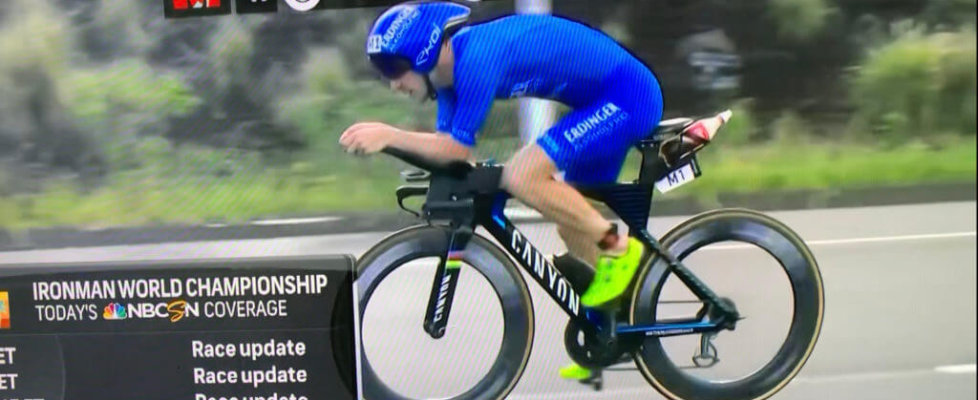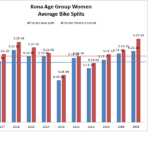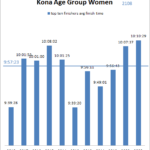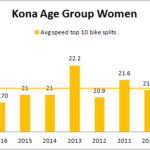How Fast Was Kona 2018 vs Historical Averages?
The fast year is ALWAYS the year you don’t go. It sure seems that way, right? Well this year the data is indisputable. 2018 is by far the fastest year for the Kona Ironman World Championships in the last 11, and maybe the fastest ever. I haven’t heard how many age-group records fell, but obviously the pro records were smashed and at least the overall female AG record was annihilated by a 45 year old no less (and with it Lisbeth’s 8-year old 45-49 course record).
First, let’s talk about “normal” Kona and what can cause it to be fast or slow. Obviously the weather is a major factor. Yet for all its micro-variability, the Kona climate in October is remarkably constant. Weather reports will usually show daily high temperatures of 82-83. It is actually reasonably comfortable in the shade. But exposure to the powerful sun will instantly raise your core temperature so it feels much hotter out on the course. Then add the black pavement and Lava, and it will be bloody hot no matter what. Occasionally, like 2016 for example, air temps were more like 90 and that will certainly add additional stress. Significant cloud cover for any period of time is rare on race day (although abundant during race week!). Madam Pele’s no pushover. But some years the clouds make temporary appearances and this can speed things up a bit vs zero cloud years like 2017. So as far as run course conditions, solar radiation time and air temps will have some effect, but it will always be fairly awful. The bike conditions may actually influence the run more than the relatively small changes in run conditions.
The swim always has some amount of swell and current. Then add varying amounts of wind chop. These each make sighting tougher and may push you off course. Some years have significant swells running – 1996 was one such year with surfers riding double-overhead waves just inshore of the swim course. The overall times however seem to vary by no more than a few minutes for the pros. Clearly 2018 was faster than normal if anything with 2 swim records cracked. So subtract a few minutes for the swim in 2018.
The bike is always the wild card. “Normal” conditions will include sweltering heat beginning within the first 10 miles, but generally favorable winds until the last 7 miles to Hawi. There, at approximately mile 53, just as the grade gets tougher, Madam Pele turns on the jets. Palm fronds are horizontal west. Winds gusts well over 20, but there may be some rain sprinkles. Speeds are typically sub-10mph in many spots due to winds combined with the grade. Once you hit the Hawi turn and start back down hill, these same winds accelerate you to ludicrous mode, but also enjoy shifting and gusting in an attempt to catch out the unwary and launch them into the lava. It is at the bottom of this white knuckle descent that the race (read suffering) begins. The 1 mile climb from Kawaihae to the Queen K is akin to riding into a Bessemer blast furnace. With some 35 miles left to go the Queen K is now stupid hot, the solar radiation is frying your skin, and the winds are raking you from off your right shoulder. How can it be so windy and yet still be so damn hot? From here back to town, the winds and heat conspire to sap any remaining fight from the athletes. This stretch is physical and mental torture, and average speeds rapidly decrease just to add to the misery. Many folks lose the race here. They overheat, dehydrate, and under-nourish. More than anything, the relative run performance can be decided here.
So why wasn’t 2018 “normal”? Heck I wasn’t there I have no idea. Actually I do – when you hear descriptions of the conditions that you have never heard in more than two decades of Kona trips, you know. Mark Allen described the morning pre-start as cool and comfortable. He was waiting for the heat to appear in transition, and it never did in the morning. The race announcers kept describing windless conditions on the bike and relatively moderate temps. On-screen graphics appeared to show the winds switching after the athletes turned at Hawi, so that they had light tail winds in both directions. Clouds were present at times. When the pros hit Hawi the trees and bushes were still. Moreover, when passing Waikaloa on the way back, bushes were still stationary. This area is typically a wind tunnel on the return. There were no signs of bikes being blown across the highway in the last 20 miles. A highly experienced and competitive multi-time Kona age grouper I know said she has never ridden the Queen K like it was on Saturday – with no cross winds.
SO HOW FAST WAS IT ALREADY?! I have been using age group women times to gauge relative difficulty and averages for Kona for some time now – obviously for one because it is useful to Lis, but also because the pros often have very different conditions than the age groupers, especially the now late-starting women. Queen K winds switch on instantly at random times – the earlier you get out there the better chance you may avoid them. Hence the pro men can have an advantage. 2017 was a clear example of this. The pro men almost entirely avoided the winds on the bike – hence the new bike record, and this years times were only slightly faster for them. But even the female pros got nailed by the winds – they start only 5 minutes later but by the time they get to the windy sections they are maybe 20 minutes back. And that can make all the difference as it clearly did in 2017 – men had record bike splits, women were average. Age groupers of course got the usual Pele cocktail.
The way I analyze the conditions is to look at the average time of the top ten female age group bike splits, and also the average time of the top ten female age group overall finishers. Finally I look at the average finishing time for the top ten female age groupers. I cover the period from 2008-present. This simple methodology shows that most years are pretty consistent. The top ten female age group bike splits average about 5:16, or 21.3 mph. The top ten overall female AG finishers’ bike splits average a bit slower, about 5:20. And the average finishing time for the top ten female AGers is about 9:57. 2018 however crushed these averages. The top ten bike split average was 4:55, or 22.7 mph! And the average finish 9:39! So the bike was about 20-21 minutes, or 1.4 mph, faster than average. Rumor has it Madam Pele was up all night playing with thunder storms so perhaps she overslept. Finishing times were slightly less faster – about 18 minutes. This is probably well within the range of error here. But assuming the swim was a few minutes faster than normal, the run, where things did get hot, may have been a bit slower than average – but then again the less-tortuous bike had to help.
Looking across the 11 years of data here, it seems that 2010,2012,2014,2016 and 2017 were “normal” overall. 2013 and especially 2018 were fast, with 2011 also being a bit speedy. 2013 gives 2018 a run for its money – which is strange because I don’t remember that much talk about it being a fast year. The 2018 bike is clearly faster, but 2013/2018 finishing times are identical. 2008, 2009, and 2015 were slow. 2016 interestingly was one of the slowest years on the bike, but overall times were average. The data also seems to indicate that slow years are a “bit” slower, by maybe 10 minutes, while very fast years can be substantially faster by around 20 minutes. The moral of the story? We may never see another year as fast as 2018 in Kona. 40-year veterans were saying they had never seen anything like 2018’s conditions. If this was your first Kona, expect to go maybe 20 minutes slower in a “normal” year. Or 30 minutes plus in a bad one. UPDATE: An astounding 14 AG records fell in 2018. Nine of these records that fell were set in the other fast year, 2013.





